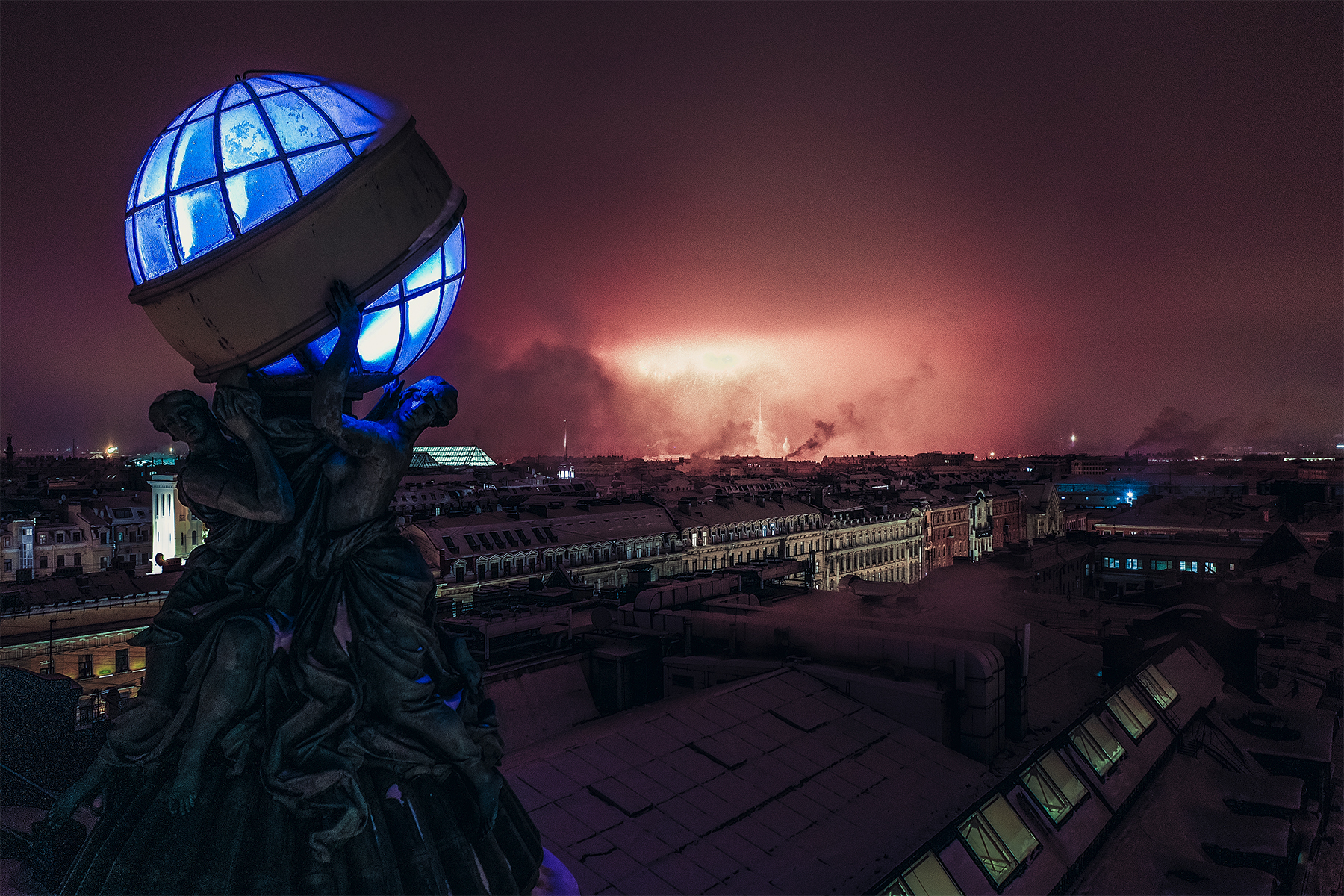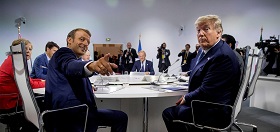The October events in Syria were an interesting indicator of the specific character of current international relations. Two NATO allies — the United States and Turkey — took opposite stands on the Kurdish issue. Washington had to introduce economic sanctions against Ankara, while Turkey conducted a military operation without so much as a backward glance at its ally. The European NATO members remained passive. Russia again consolidated its positon, spending minimal resources and maintaining equidistant relations with the key regional power centers. Iran remains an influential player in Syria despite enormous US economic pressure. Moreover, its determination to capitalize on its potential in the country and the region is increasing in proportion to Washington’s growing urge to punish Tehran.
These events return us to one of the basic questions of the science on international relations: What are the parameters of power enjoyed by modern government players? What makes some stronger and others weaker? Is there a universal formula for power and influence that produces success under different circumstances?
In all probability, these events may be considered a triumph of “agents” over “structures.” Some players show that their actions pursue quite specific pragmatic interests and that their political will prevails over the established structural restrictions, be it alliances, international institutions or allied commitments. The very policy of “agents,” that is to say, individual states, does not fit in into the linear logic of “the more the better.” Minimal pinpoint actions that result from sophisticated combinations or simple good luck yield serious dividends, whereas enormous power, resources and funds do not guarantee success.
The October events in Syria were an interesting indicator of the specific character of current international relations. Two NATO allies — the United States and Turkey — took opposite stands on the Kurdish issue. Washington had to introduce economic sanctions against Ankara, while Turkey conducted a military operation without so much as a backward glance at its ally. The European NATO members remained passive. Russia again consolidated its positon, spending minimal resources and maintaining equidistant relations with the key regional power centers. Iran remains an influential player in Syria despite enormous US economic pressure. Moreover, its determination to capitalize on its potential in the country and the region is increasing in proportion to Washington’s growing urge to punish Tehran.
The powerful financial and military resources of the Gulf monarchies are not helping them play a decisive role in Syria or otherwise. An ever growing China, which looms beyond the horizon, still tries to distance itself from the Middle East affairs as a matter of principle, but its de facto presence makes it part of the equation. Against the backdrop of an ostensible retreat in Syria, the United States carried out a blitzkrieg operation to destroy the leader of ISIS (banned in Russia) with what US officials describe as tacit support by Russia, the Syrian Government, Turkey, Iraq and the Kurds. However, the Americans will not leave the Syrian oil fields, while maintaining a strict oil embargo against Syria.
In all probability, these events may be considered a triumph of “agents” over “structures.” Some players show that their actions pursue quite specific pragmatic interests and that their political will prevails over the established structural restrictions, be it alliances, international institutions or allied commitments. The very policy of “agents,” that is to say, individual states, does not fit in into the linear logic of “the more the better.” Minimal pinpoint actions that result from sophisticated combinations or simple good luck yield serious dividends, whereas enormous power, resources and funds do not guarantee success. Needless to say, it is too early to write off structural factors. After all, allied relations between the US and Turkey have alleviated political differences on individual issues more than once. But deals are increasingly situational, and strategic horizons are eroded by tactical tasks. It is also premature to write off the power of states. As Kenneth Waltz aptly put it, strong states may certainly err, and weak countries can be more successful in certain situations. However, strong states are more resilient and can afford to make more attempts. So, if strong countries can afford the luxury of being wrong, any mistake can become fatal for the weak.
These events return us to one of the basic questions of the science on international relations: What are the parameters of power enjoyed by modern government players? What makes some stronger and others weaker? Is there a universal formula for power and influence that produces success under different circumstances?
Attempts to find a universal formula for comparing all states have been made for a long time and are still popular. Most formulas are based on the parameters of economy and military might. Thus, Expected Utility Generation, the well-known US project by Scott Bennett and Allan Stam, uses parameters like the numerical strength of the armed forces, defense expenditures, power generation, metal smelting, total population and urban population. Despite the relativity of these parameters, an emphasis on the economy and military potential is typical of universal comparisons. The big problem is how to fine tune the indexes to take into account various nuances. A Russian project, The Political Atlas of Modern Times, by Andrei Melvil et al attempted to take into consideration these nuances plus technological development and soft power indices.
However, universal power formulas have shortcomings. The first is that any global distribution of power will be asymmetrical. This is a reflection of objective reality and is hardly a drawback of the method as such. Almost any power potential index reveals one super leader, several leaders and the remaining mass of states that are behind them by dozens and even hundreds of times. The use of such a projection is not helpful in explaining specific situations with the participation of local players that are formally weak but may prove indispensable under specific circumstances. In addition, a departure from linearity occurs when it comes to the quality of interstate relations. For instance, there is no doubt that the United States is much more powerful than Russia, India or China. But a scenario of US military aggression against any of these states is most unlikely because of its high price. Moreover, when a potential armed action is discussed against Iran, a much weaker non-nuclear country, the United States will think twice and has so far rejected this path because the price may also prove to be too high. In other words, the ratio of power is not indicative of the quality of relations between states.
Another shortcoming is that power parameters coexist with other dimensions of the life of an “agent” or a modern state. Statistically, they may have little connection with power parameters. There are both democracies and autocracies among powerful states. Some of them are prosperous whereas others have lower living standards. There are federations and centralized states among them. Corruption is at different levels as well. In other words, the realists seem to be right when they urge us to separate power and foreign policy from government systems and domestic political issues. However, in some cases, these parameters suddenly begin to play a crucial role. In 1989, the USSR, in statistical terms, was in fairly good shape. It was a superpower with the world’s second largest economy, decent demographic potential, advanced industry and technology, and the world’s best army. But it collapsed like a house of cards in a minute, judging by the historical standards. And a no small role was played by factors that cannot be measured at all — the condition of the elites, the “crisis of the spirit and willpower,” the underlying nihilism and total cynicism as regards the dominant ideology. Similarly intangible parameters brought Russia back to the supreme league of world politics, when formally it had long been written off as a “slowly waning state” and “a leftover of the empire” with a reactive foreign policy, and a population that was becoming extinct and drinking itself to death, a country without any outlook for a future.
Interestingly, the Political Atlas revealed an important regularity. If power is considered not just by itself but in combination with other parameters of a state’s life — its political system, quality of life, the condition of statehood and the level of threats — the picture of the world will be somewhat different. Instead of a linear scale, a kaleidoscope of different clusters of states emerges. Moreover, each cluster has its own dimension. In other words, modern states exist in parallel realities as it were, and each reality has criteria and parameters of its own. The club of great powers has one set of dimensions and agendas. The cluster of advanced states with relatively small militaries has another. The cluster of underdeveloped states that are fighting for their survival has still another. The problem is aggravated by the fact that these clusters and their agendas are permeable. One fine day a state from the great power cluster can knock on the door of a state from an underdeveloped or even a “well-off” cluster with its not always welcome agenda in the shape of bombing raids, clandestine operations, economic sanctions or open interventions.
Of course, our main task is to figure out what this means for Russia. A trivial but frequently ignored truth is that Russia is a fairly unique country by global conventions. For many years, we have been involved in self-castigation, trying to be like someone else. Just look at how fast India and China are growing! And what about us? Look at what a nice life the Germans have! Why can’t we? Look at South Korea’s great chaebols! Why don’t we have this? Look at how pushy and unceremonious the Americans are! Why not do the same? How well does democracy work in Switzerland! But what about us? We are like an underachiever whose parents lecture and hector him every day, pointing to other children in the neighborhood as an example to emulate. Basil plays chess, Peter plays the violin, Nick already helps his dad in the store, and Mary is an A student and a member of two hobby groups. But you are just good for nothing, a big guy with an evil look, in a torn school uniform, with bad marks and a black eye. The problem (and possibility) lies in the fact that this underachiever will never become a Basil, a Peter, a Nick, or a Mary even in theory. However, this doesn’t mean that he has no hope or his own formula for success. The dilemma is whether he should try to match his “successful” classmates or follow his own path.
If “agents” are replacing “structures” in modern international relations, maybe it is worth changing the analytical lens through which we look at “agents,” especially an unconventional agent like Russia. Maybe, we should proceed from the qualities of an “agent” rather than universal formulas with which we study “structures.” This issue is important from both methodological and political points of view. In the final count, we are talking about the sources of our political identity. We could look for it in a “structure,” trying to conform to a universal criterion. But we can also look for it in our own selves — our specifics, balance of strong and weak points, and eventually in our history and culture. It is possible that we will have to rediscover ourselves anew.
First published in the Valdai Discussion Club.







